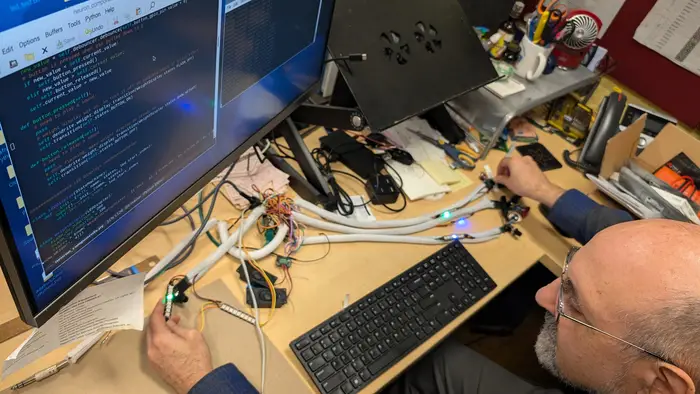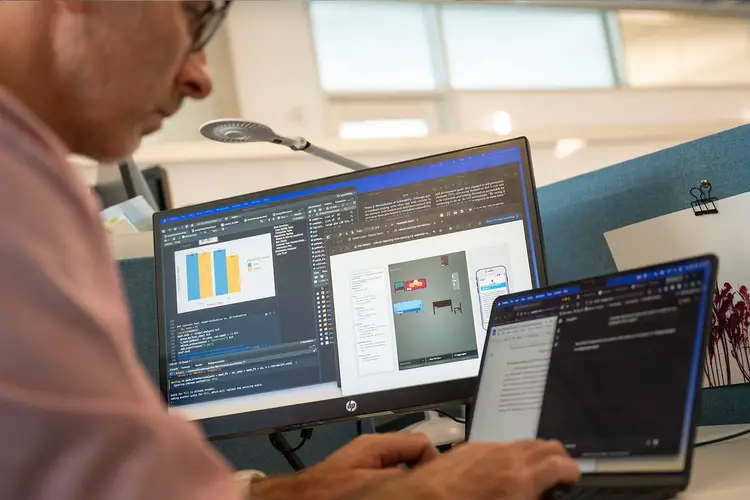
Plush Neuron Makes AI Approachable
Tactile tool simplifies neural networks for middle schoolers
Media Inquiries
A team at Carnegie Mellon University is helping kids understand artificial intelligence with a soft, squishy, LED-lit neural network.
“Everyone, even middle schoolers, needs to know a little about these building blocks of artificial intelligence, just like it’s important to know the basics of how electricity works or what a molecule is,” said Computer Science Department(opens in new window) Research Professor Dave Touretzky(opens in new window). “But these young learners haven’t even studied algebra yet — so how can we help them understand the computational abilities of these complex networks?”
Touretzky, a member of CMU's Neuroscience Institute(opens in new window), has long researched K–12 AI education. He investigates effective ways to teach young learners about AI technology. Now, thanks to facilities and expertise contained within the Integrative Design, Arts and Technology (IDeATe) network, he and a team of staff, faculty and students have brought the Plush Neuron to life. These 3-foot, brightly colored, interactive computational devices allow middle schoolers to experience and influence the way AI makes decisions firsthand.
Ideation
The Plush Neuron was designed to help students visualize the basic elements of neural network technology — the machine-learning model that powers much of modern AI. It’s the physical counterpart to Neuron Sandbox(opens in new window), a browser-based tool Touretzky created that allows students to follow along with a series of increasingly difficult decision problems and visualize how a computer arrives at a solution.
Touretzky programmed the neuron’s software and IDeATe Technical Specialist Cody Soska(opens in new window) developed its electronic hardware, serving as the project design-engineer as part of his graduate studies.
“This project is a true example of the stars aligning to make something really cool in service of AI education. It’s interdisciplinary at all levels,” Soska said. Between his electronics and Touretzky’s code, a framework for the Plush Neuron soon emerged, ready for the next step of production.
Fabricating the neuron
Dietrich College of Humanities and Social Sciences(opens in new window) senior Zarmond Goodman, who works as a senior tech adviser(opens in new window) in IDeATe, joined the team once the working prototype was finished. As a film and visual media major minoring in physical computing and art, Goodman’s role was to replicate Soska’s design and assemble the pieces into 10 individual neurons.
“Being able to work on a project like this is the epitome of why IDeATe is cool,” they said. ” I was able to combine my interests in different ways — all while working alongside people I’ve looked up to since I became involved with IDeATe my first year at CMU.”
Goodman followed along as Soska walked them through the design, then took over soldering the components. They helped with other aspects as well, including filming and editing a demo video(opens in new window) showcasing the neuron.
“Hundreds of hours went into building these neurons, and Zarmond was essential to completing the project,” Soska said. “Their work really made the whole thing possible.”
Next, Soska recruited Teaching Professor Olivia Robinson(opens in new window), who leads IDeATe’s Soft Technologies(opens in new window) minor, along with Soft Technologies instructor Natalya Pinchuk. The team needed their expertise with textiles to craft the final form of the neuron: something bright, tactile and appealing for children.
The plush body of the neuron had to accomplish three goals. First, it had to be squishy to pad the wires and other electronic components and feel soft when handled. At the same time, it had to keep electronic components stable, with knobs and displays embedded in the surface maintaining their position within the neuron. Finally, it had to keep its shape, resisting the tendency to droop when raised into the air.
“One of our biggest challenges was designing a streamlined form that could also hold a large shoebox’s worth of electronics,” Robinson recalled. “Beneath its cohesive and bright exterior, the plushy’s body is built from layers of foam and custom ‘shapewear’ that we made to keep everything in place and give shape to the outer materials. I still find it satisfying to put it together and think back on all the inventive choices that emerged along the way.”
Pinchuk agreed.
“The vision was to provide kids with a learning tool that was tactile, interactive and fun. A textile is uniquely suited to accomplish that, offering a sensory experience that invites touch and engagement,” Pinchuk added. “The plushy form taps into feelings of play, comfort, safety, and the quiet magic of childhood — qualities that make the learning experience more approachable, memorable, and emotionally resonant.”
Neuron in action
A completed Plush Neuron is a simplified version of how real neural networks work — designed for small hands and big questions.
The neuron features three inputs on one end, called “dendrites,” which have buttons that can be squeezed to send weighted input signals (adjusted with a rotary switch). The dendrite's LED display shows the current weight value, which can range from -4 (lit by red LEDs) to +4 (lit by green LEDs).
Inputs are then sent to the body, or “soma,” where they are summed up and compared to the threshold displayed on another LED array. If the inputs are greater than the threshold, the long axon at the other end flashes lights and plays a sound to let the user know the neuron is “firing.”
Weights and thresholds can be adjusted to pose a variety of simple decision problems. “The neuron illustrates ethics in AI by showing the importance of weighting decisions,” Soska explained. “With it, you can write and solve full-scale logic problems using the same computational logic that AI uses — how it makes decisions, and how bias is introduced.”
From symposiums to middle school classrooms, the Plush Neuron is already sparking curiosity in educators across the country. The project debuted this past March at EAAI-25(opens in new window), the 15th Symposium on Educational Advances in Artificial Intelligence. In June, the team took it to Atlanta for an AI4MiddleSchools Cohort(opens in new window) curriculum workshop, where it was used to train teachers for the first time. Then, in August, Soska presented at the International Symposium on Academic Makerspaces(opens in new window) (ISAM) held at the University of California, Berkeley.
This fall, the team sent completed neurons to Christina Gardner-McCune, a professor at the University of Florida who leads the AI4MiddleSchools project; Amber Jones, a computer science education consultant and former middle school teacher in Atlanta; and Will Hanna, a computer science teacher at Thomas County Middle School in Georgia. These early partners, who have previously championed AI education alongside Touretzky as part of the Artificial Intelligence for Georgia (AI4GA)(opens in new window) project, will be the first to test the Plush Neuron in the field.
Work That Matters
Researchers at CMU are working on real world solutions to the biggest challenges.
Read more about the latest discoveries.(opens in new window)







